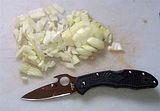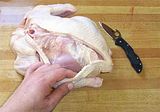
| The review of the Spyderco Wave/Delica consists of : |

|
The Wave/Delica in VG10 stainless steel is the same as the regular Delica aside from the addition of the Emerson Wave. The primary flat grind tapers to an edge 0.019 (1)" thick and 14.0 (7) degrees per side.
With the origional edge profile and new in box sharpness, the M16 cut 3/8 inch hemp with 8.5 (5) and 20.5 (5) lbs on a slice through two inches of blade and a push cut respectively..
The Wave/Delica tips tapers through 1.05" at an angle of 2.6 degrees. On a 50 lbs push it sinks to a depth of 151 (3) pages into a standard phonebook.
 | The general cutting ability of the Wave/Delica is high. It doesn't match the performance of an Opinel however on small fruits and vegetables the force is very low and just a pound or two more on cuts than a truely optomized kitchen knife. Specifically, slicing a small onion it took two lbs with the Wave/Delica vs one lbs for a japanese utility knife. On an apple which is more dense and thus binds more, the force is three and one lbs respectively. The main drawback of the Wave/Delica for such work is making the horizontal cuts to allow fine dicing. This is awkward compared to a knife like the Calpyso Jr. which has a more acute grind. Knives like the Jess Horn with the more precise tip and narrow blade also allow easier coring and better turning in cuts. |
 |
 In general the most significant disadvantage to using such a knife in the kitche
is the lack of a dropped blade and the effect it has on using a cutting board
especially for fine dicing. Using
a japanese utility knife for sutting up
some small hot peppers and onions for a stir fry is very efficient using a
pinch grip around the top of the handle and a chopping motion. In comparion
these cuts have to be made using a draw through the foods with the Wave/Delica
which isn't as productive.
In general the most significant disadvantage to using such a knife in the kitche
is the lack of a dropped blade and the effect it has on using a cutting board
especially for fine dicing. Using
a japanese utility knife for sutting up
some small hot peppers and onions for a stir fry is very efficient using a
pinch grip around the top of the handle and a chopping motion. In comparion
these cuts have to be made using a draw through the foods with the Wave/Delica
which isn't as productive.
| On meats the Wave/Delica works well. The initial high sharpness allows ready trimming of skin and fats for rendering and the grip is comfortable and secure even when lubricated with fats/oils. It has no problem breaking down a seven lbs chicken for cooking and stock. It readily removing the breasts and slices off the legs and wings. In general, more length is appreciated here and an Endura or Military is more efficient or fixed blades like the South Fork. |
 |
 |
 The Delica also works very well in general for utility cuts on meat. It readily
takes down some salted pork riblet for pea soup. The very sharp edge slides
through meat and connective tissue with ease. The edge is also durable enough to
cut around the joints and shearing through the outer parts of the joints readily
with no effect on the edge. Tasks like this and the chicken cutting would not be
performed with the
japanese utility knife as the edge
doesn't have the necessary durability as it is too thin.
The Delica also works very well in general for utility cuts on meat. It readily
takes down some salted pork riblet for pea soup. The very sharp edge slides
through meat and connective tissue with ease. The edge is also durable enough to
cut around the joints and shearing through the outer parts of the joints readily
with no effect on the edge. Tasks like this and the chicken cutting would not be
performed with the
japanese utility knife as the edge
doesn't have the necessary durability as it is too thin.
 | As a wood splitter, the Wave/Delica has no ability on its own, simply due to size, even heavy folders like the Manix can only chop split really small wood. However the Wave/Delica can be used directly to split wood by hammering on the spine with a piece of wood to drive the knife through the wood. It is also more robust than knives like the U2 and can thus be used to pry apart woods to continue the splitting. However this is best restrained to just light to medium wrist pressure and VG-10 won't bend significantly before it breaks which is always a concern when prying. In general, unless the wood is small and relatively easy to split like clear pine or cedar, a direct approach isn't effective. However the Wave/Delica readily carves wedges from pieces of scrap hardwoods, or even soft woods and this will allow splitting of larger and even knotty and twisted woods. The initial cut is made by drivnig the Wave/Delica into the wood and then it is rotated out and the wedges pounded in. The splitting can be continued as necessary to reduce the wood to the required size or shape. The wedges will need to be sharpened after use unless they are very dense hardwoods or fire hardened. |
 |
| For carving/shaping wood, the Wave/Delica works well as noted in the above by the performance on the basswood dowel. It isn't in the same class as folders like the Opinel which are optomized for wood work, however it is far ahead of knives like the Fulcrum. For most shaping it is best to start off by splitting the wood which not only prevents from having to whittle off a lot of waste stock, it can also give multiple pieces to work with. The above split of the small round into two pieces was used to make a small spatula and mixing spoon. After the splitting the wood is made much easier by using a saw to make a number of cuts in the sides of the slabs. The Wave/Delica can then be batoning lightly to effectively chop off the small pieces of wood inbetween the cuts. With the handle thus roughly shaped the knife readily slices off the rest of teh wood to get the necessary contour as well as flatten the spatula blade. The hollow of the spoon is achieved by just crosshatching the wood with the point until it weakens and comes out. It can also be burned out with coals, but that takes a *long* time. The curvature of the necks on the tools is achieved by gripping the blade forward over the blade and making the cuts with the last inch of the knife. For work of this type a small axe or large chopping blade does make it a lot less time consuming as the rough shaping is much faster. |
 |
 | |
 | |
 |
 For fire starting,
using many of the methods previously described the
Wave/Delica readily obtains tinder in many forms and as well can gather and
break down larger pieces of wood for continued fuel. If necesary all elements
can be gathered from a piece of deadfall, from fine scrapings, to shavings, to
small splits and larger slabs. The Endura tends to
be more productive for most of these tasks due to the longer and more robust
blade, aside from the fine
scrapings/shavings which are done equally well with both knives.
For fire starting,
using many of the methods previously described the
Wave/Delica readily obtains tinder in many forms and as well can gather and
break down larger pieces of wood for continued fuel. If necesary all elements
can be gathered from a piece of deadfall, from fine scrapings, to shavings, to
small splits and larger slabs. The Endura tends to
be more productive for most of these tasks due to the longer and more robust
blade, aside from the fine
scrapings/shavings which are done equally well with both knives.
 Moving on to materials which can bind on a blade and thus place demands on the
grind, the Wave/Delica continues to be an efficient choice. It easily sliced up
stryofoam with no cracking or splitting and could make very fine slices, less
than 1/16" thick with no problems.
Using it alongside a reprofiled Delica, Jess Horn, and Opinel to slice some 1/4" double layed cardboard,
the performance was near idental with all blades. They all needed between 6-8
lbs to make a eight inch cut using a push on a 45 degree angle. The Wave/Delica
did have a thicker and more obtuse edge than the other blades which made the
initial starting cut a little more difficult, but as all the blades had similar
blade stocks, the deep cutting performance was not significantly different.
Moving on to materials which can bind on a blade and thus place demands on the
grind, the Wave/Delica continues to be an efficient choice. It easily sliced up
stryofoam with no cracking or splitting and could make very fine slices, less
than 1/16" thick with no problems.
Using it alongside a reprofiled Delica, Jess Horn, and Opinel to slice some 1/4" double layed cardboard,
the performance was near idental with all blades. They all needed between 6-8
lbs to make a eight inch cut using a push on a 45 degree angle. The Wave/Delica
did have a thicker and more obtuse edge than the other blades which made the
initial starting cut a little more difficult, but as all the blades had similar
blade stocks, the deep cutting performance was not significantly different.
The Wave/Delica sharpened readily, the thin and acute edge allows it to be honed readily on most jigs and v-rods, and freehanded it responded well to a variety of hones. This one was left at the stock edge profile to keep as a standard reference for small folders.
The lock back of the Wave/Delica was stable under spine impacts, torques and white knuckling, consistent with the performance of other samples of the same model.
The Wave/Delica has a full four way position clip as the standard version and is identical aside from the Wave opener, which means that the knife will open as the blade is drawn with no effort from the user aside from a light rotation of the wrist outward to allow the hook to catch on the top of the pocket. In very tight pants this happens on a straight draw. It can be prevented by a light rotation in the opposite direction.
The grip is the same as the one found on the regular Delica, detailed comments can be see in the review of the PE Delica.
The Delica is a solid choice for a small folder which is willing to trade some cutting ability to get more robustness over say the Calypso Jr. . The Wave/Delica adds the ability of the knife to open as it is drawn. It also gives a small prying tool which can be used as a bottle opener.
Comments can be emailed to cliffstamp[REMOVE]@cutleryscience.com
More information can be obtained at the Spyderco website. PhotoBucket.
| Last updated : | 07 : 20 : 2006 |
| Originally written: | 07 : 20 : 2006 |